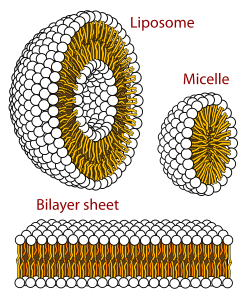Lipid/ja: Difference between revisions
Created page with "thumb|250px|[[phospholipid/ja|リン脂質の自己組織化:球状のリポソーム、ミセル、脂質二重層。]]" Tags: Mobile edit Mobile web edit |
Created page with "生体膜はラメラ相の一形態である。脂質二重膜の一形態である。脂質二重膜の形成は、上記のグリセロリン脂質が水性環境にあるとき、エネルギー的に好ましいプロセスである。これは疎水効果として知られている。水系では、脂質の極性頭部は極性の高い水環境に向かって整列し..." Tags: Mobile edit Mobile web edit |
||
| Line 90: | Line 90: | ||
[[File:Phospholipids aqueous solution structures.svg|thumb|250px|[[phospholipid/ja|リン脂質]]の自己組織化:球状の[[liposome/ja|リポソーム]]、[[micelle/ja|ミセル]]、[[lipid bilayer/ja|脂質二重層]]。]] | [[File:Phospholipids aqueous solution structures.svg|thumb|250px|[[phospholipid/ja|リン脂質]]の自己組織化:球状の[[liposome/ja|リポソーム]]、[[micelle/ja|ミセル]]、[[lipid bilayer/ja|脂質二重層]]。]] | ||
生体膜は[[lamellar phase/ja|ラメラ相]]の一形態である。[[lipid bilayer/ja|脂質二重膜]]の一形態である。脂質二重膜の形成は、上記の[[glycerophospholipids/ja|グリセロリン脂質]]が水性環境にあるとき、エネルギー的に好ましいプロセスである。これは[[hydrophobic effect/ja|疎水効果]]として知られている。水系では、脂質の極性頭部は極性の高い水環境に向かって整列し、疎水性尾部は水との接触を最小限に抑えて互いに集まり、[[vesicle (biology)/ja|小胞]]を形成する傾向がある;脂質の[[critical micelle concentration/ja|濃度]]に依存して、この生物物理学的相互作用は、[[micelle/ja|ミセル]]、[[liposomes/ja|リポソーム]]、または[[lipid bilayer/ja|脂質二重層]]の形成をもたらすかもしれない。他の凝集も観察され、それが[[amphiphile/ja|両親媒性]](脂質)の振る舞いのポリモルフィズムの一部を構成している。[[Phase behaviour/ja|位相挙動]]は[[biophysics/ja|生物物理学]]の研究領域の一部である。ミセルおよび二重層は、親水性媒体中で親水性効果として知られるプロセスによって形成される。親脂性または両親媒性の物質を極性の環境に溶解する際、極性分子(すなわち、水の場合は水溶液中の水分子)は溶解された親脂性物質の周りでより秩序立って配置されるようになる。これは、極性分子が両親媒性物質の親脂性領域に水素結合を形成できないためである。その結果、水分子は水溶液中の溶解された親脂性分子の周りに整然とした"[[clathrate/ja|クラスレート]]" ケージを形成する。 | |||
<div lang="en" dir="ltr" class="mw-content-ltr"> | <div lang="en" dir="ltr" class="mw-content-ltr"> | ||
Revision as of 10:24, 25 February 2024

脂質は、脂肪、ワックス、ステロール、脂溶性ビタミン(ビタミンA、D、E、Kなど)、モノグリセリド、ジグリセリド、リン脂質などの有機化合物の広いグループである。脂質の機能には、エネルギーの貯蔵、シグナル伝達、細胞膜の構造成分としての作用などがある。脂質は化粧品や食品、そしてナノテクノロジーにも応用されている。
脂質は広義には疎水性または両親媒性の低分子と定義される。一部の脂質は両親媒性の性質を持つため、小胞、多層/一枚膜リポソーム、または水性環境中の膜などの構造を形成することができる。生物学的脂質は、2つの異なるタイプの生化学的サブユニットまたは「ビルディング・ブロック」から全体的または部分的に生じる: ケトアシル基とイソプレン基である。このアプローチを用いると、脂質は8つのカテゴリーに分けられる: 脂肪アシル類、グリセロ脂質類、グリセロリン脂質類、スフィンゴ脂質類、糖脂質類、ポリケチド類(ケトアシルサブユニットの縮合から誘導される)、およびステロール脂質とプレノール脂質(イソプレンサブユニットの縮合から誘導される)である。
脂質という用語は脂肪の同義語として使われることもあるが、脂肪はトリグリセリドと呼ばれる脂質のサブグループである。脂質はまた、脂肪酸およびその誘導体(トリ、ジ、モノグリセリド、リン脂質を含む)、ならびにコレステロールのような他のステロールを含む代謝産物のような分子を包含する。ヒトをはじめとする哺乳類は、脂質の分解にも合成にも様々な生合成経路を利用しているが、必須脂質の中にはこの方法では作れないものもあり、食事から摂取しなければならないものもある。
歴史
1815年、Henri Braconnotは脂質(graisses)をsuifs(固形油脂)とhuiles(流動油脂)の2つに分類した。1823年、Michel Eugène Chevreulは、油脂、獣脂、ワックス、樹脂、バルサム、揮発油(または精油)を含む、より詳細な分類を開発した。
最初の合成トリグリセリドは1844年にThéophile-Jules Pelouzeによって報告され、彼は濃厚な硫酸の存在下で酪酸をグリセリンで処理してトリブチリンを生成した。数年後、Pelouzeの弟子の一人であったMarcellin Berthelotは、類似の脂肪酸を高温で気体の塩化水素の存在下でグリセリンと反応させることによってトリステアリンとトリパルミチンを合成した。
1827年、ウィリアム・プラウトは、タンパク質(「アルブミン質」)、炭水化物(「サッカリン質」)とともに、脂肪(「油性」消化物)を人間や動物にとって重要な栄養素であると認識した。
1世紀もの間、化学者たちは「脂肪」を脂肪酸とグリセロール(グリセリド)からなる単純な脂質としかみなしていなかったが、後に新しい形態が報告された。セオドア・ゴブリー(1847年)は、哺乳類の脳と鶏卵からリン脂質を発見し、彼はこれを「レシチン類」と呼んだ。トゥディクムは、ヒトの脳からリン脂質(セファリン)、糖脂質(セレブロシド)、スフィンゴ脂質(スフィンゴミエリン)を発見した。
リポイド、リピン、リピド、リピッドという用語は、著者によってさまざまな意味で使われてきた。1912年、ローゼンブルームとギースは「リポイド」を「リピン」に置き換えることを提案した。1920年、Bloorは「リポイド」に新しい分類を導入した:単純リポイド(グリースとワックス)、複合リポイド(リン脂質と糖脂質)、派生リポイド(脂肪酸、アルコール、ステロール)。
ギリシャ語のλίπος「リポス」「脂肪」に語源を持つリピドという言葉は、1923年にフランスの薬理学者ガブリエル・ベルトランによって紹介された。ベルトランは従来の脂肪(グリセリド)だけでなく、複雑な構造を持つ「リポイド」もこの概念に含めた。1923年7月3日のSociété de Chimie Biologique国際委員会の本会議において、lipideという言葉は満場一致で承認された。lipideという単語は、後にその発音('lɪpɪd)からlipidと英語化された。フランス語では、-ideという接尾辞は、古代ギリシャ語の-ίδης(「の息子」または「の子孫」という意味)に由来し、常に(ɪ)と発音される。
1947年、T. P. Hilditchは「単純脂質」をグリースとワックス(真性ワックス、ステロール、アルコール)と定義した。
カテゴリー
脂質は、脂質MAPSコンソーシアムによって以下の8つのカテゴリーに分類されている:
脂肪アシル

。

。
脂肪酸は、脂肪酸合成と呼ばれるプロセスにおいて、アセチル-CoAプライマーとマロニル-CoAまたはメチルマロニル-CoA基との鎖延長によって合成される分子の多様なグループである。脂肪酸はカルボン酸基で終端する炭化水素鎖でできており、この配置により分子は極性を持つ親水性の末端と、水に不溶性である非極性の疎水性の末端を持つ。脂肪酸構造は、生体脂質の最も基本的な分類の一つであり、より構造的に複雑な脂質の構成要素としてよく用いられる。炭素鎖は通常4〜24個の長さで、飽和または不飽和であり、酸素、ハロゲン、窒素、および硫黄を含む官能基が結合している場合がある。脂肪酸が二重結合を含む場合、シスまたはトランスの幾何異性体の可能性があり、これは分子の構成に大きく影響する。シス-二重結合は脂肪酸鎖を曲げる原因となり、鎖中の二重結合が多いほどその効果は増す。植物のチラコイド膜に最も多く存在する脂肪酸アシル鎖である炭素数18のリノレン酸には3つの二重結合があり、低温環境にもかかわらず、これらの膜を非常に流動的にしている。このことは、細胞膜の構造と機能に重要な役割を果たしている。天然に存在する脂肪酸のほとんどはシス型であるが、天然油脂や部分的に水素添加された油脂にはトランス型も存在する。
生物学的に重要な脂肪酸の例としては、主にアラキドン酸とエイコサペンタエン酸から誘導されるエイコサノイドがあり、これにはプロスタグランジン、ロイコトリエン、トロンボキサンが含まれる。ドコサヘキサエン酸もまた、生体系、特に視力に関して重要である。脂肪酸カテゴリーの他の主要な脂質クラスは、脂肪エステルと脂肪アミドである。脂肪エステルには、ワックスエステル、脂肪酸チオエステルコエンザイムA誘導体、脂肪酸チオエステルACP誘導体、脂肪酸カルニチンなどの重要な生化学的中間体が含まれる。脂肪アミドとしては、カンナビノイド神経伝達物質アナンダミドなどのN-アシルエタノールアミンが挙げられる。
グリセロ脂質

グリセロ脂質は一置換、二置換、三置換のグリセロールから構成され、最もよく知られているのはトリグリセリドと呼ばれるグリセロールの脂肪酸トリエステルである。"トリアシルグリセロール"は"トリグリセリド"と同義語として使われることもある。これらの化合物では、グリセロールの3つのヒドロキシル基がそれぞれ、典型的には異なる脂肪酸によってエステル化されている。エネルギー貯蔵物質として機能するため、これらの脂質は動物組織の貯蔵脂肪の大部分を占める。トリグリセリドのエステル結合の加水分解と脂肪組織からのグリセロールと脂肪酸の放出は脂肪を代謝する最初のステップである。
グリセロ脂質の付加的なサブクラスはグリコシルグリセロールで代表され、1つ以上の糖残基がグリコシド結合を介してグリセロールに結合していることが特徴である。このカテゴリーの構造の例としては、植物膜に見られるジガラクトシルジアシルグリセロールや哺乳類の精子細胞のセミノリピドがある。
グリセロリン脂質

グリセロリン脂質は通常リン脂質と呼ばれ(ただし、スフィンゴミエリンもリン脂質に分類される)、自然界に普遍的に存在し、細胞の脂質二重層の主要成分であるとともに、代謝や細胞シグナル伝達にも関与している。 神経組織(脳を含む)には比較的多量のグリセロリン脂質が含まれており、その組成の変化がさまざまな神経疾患に関与している。グリセロリン脂質は、真核生物や真正細菌ではグリセロール骨格のsn-3位、古細菌ではsn-1位にある極性ヘッドグループの性質に基づいて、異なるクラスに細分化されることがある。
生体膜に存在するグリセロリン脂質の例としては、ホスファチジルコリン(PC、GPChoまたはレシチンとしても知られる)、ホスファチジルエタノールアミン(PEまたはGPEtn)、およびホスファチジルセリン(PSまたはGPSer)が挙げられる。細胞膜の主成分や細胞内・細胞間タンパク質の結合部位としての役割に加え、ホスファチジルイノシトールやホスファチジン酸などの真核細胞のグリセロリン脂質は、膜由来のセカンドメッセンジャーの前駆体であるか、それ自体である。典型的には、これらの水酸基の一方または両方が長鎖脂肪酸でアシル化されているが、アルキル結合や1Z-アルケニル結合(プラズマローゲン)のグリセロリン脂質も存在し、古細菌ではジアルキルエーテルの変異体も存在する。
スフィンゴ脂質

スフィンゴ脂質は、アミノ酸セリンと長鎖脂肪アシルCoAからデノボ合成で合成されるスフィンゴイド塩基骨格という共通の構造的特徴を持ち、その後セラミド、リン脂質、スフィンゴ糖脂質などに変換される複雑な化合物群である。哺乳類の主要なスフィンゴイド塩基は一般にスフィンゴシンと呼ばれている。セラミド(N-アシルスフィンゴイド塩基)は、アミド結合脂肪酸を持つスフィンゴイド塩基誘導体の主要なサブクラスである。脂肪酸は一般的に飽和またはモノ不飽和で、鎖長は16から26炭素原子である。
哺乳類の主要なスフィンゴ糖脂質はスフィンゴミエリン(セラミドホスホコリン)であるが、昆虫は主にセラミドホスホエタノールアミンを含み、真菌類はフィトセラミドホスホイノシトールとマンノースを含む頭部基を持つ。スフィンゴ糖脂質は、スフィンゴイド塩基にグリコシド結合を介して結合した1つ以上の糖残基からなる分子の多様なファミリーである。その例として、セレブロシドやガングリオシドなどの単純および複雑なスフィンゴ糖脂質が挙げられる。
ステロール

。
コレステロールやその誘導体などのステロールは、グリセロリン脂質やスフィンゴミエリンとともに膜脂質の重要な構成成分である。ステロールの他の例としては、胆汁酸とその結合体があり、哺乳類ではコレステロールの酸化誘導体であり、肝臓で合成される。植物に相当するものはβ-シトステロール、スチグマステロール、ブラシカステロールなどの植物ステロールであり、後者の化合物は藻類の成長のバイオマーカーとしても使用される。真菌の細胞膜で優勢なステロールはエルゴステロールである。
ステロールはステロイドであり、水素原子の一つが炭素鎖の3位でヒドロキシル基に置換されている。ステロイドと共通するのは、同じ縮合4環コア構造である。ステロイドはホルモンとシグナル伝達分子として異なる生物学的役割を持つ。炭素数18(C18)のステロイドにはエストロゲンファミリーが含まれ、C19のステロイドにはテストステロンやアンドロステロンなどのアンドロゲンが含まれる。C21サブクラスには、グルココルチコイドやミネラルコルチコイドと同様に、プロゲストーゲンが含まれる。様々な形態のビタミンDからなるセコステロイド類は、コア構造のB環の開裂によって特徴づけられる。
プレノール

プレノール脂質は、主にメバロン酸(MVA)経路で生成される炭素数5ユニットの前駆体イソペンテニル二リン酸とジメチルアリル二リン酸から合成される。単純なイソプレノイド(直鎖アルコール、二リン酸など)はC5単位の連続的な付加によって形成され、これらのテルペン単位の数によって分類される。40以上の炭素を含む構造はポリテルペンとして知られている。カロテノイドは抗酸化物質として、またビタミンAの前駆体として機能する重要な単純イソプレノイドである。もう一つの生物学的に重要な分子のクラスはキノン類とヒドロキノン類に代表され、これらは非イソプレノイド起源のキノイド核に結合したイソプレノイド尾部を含む。ビタミンEやビタミンK、ユビキノンはこのクラスの例である。原核生物が合成するポリプレノール(バクトプレノールと呼ばれる)は、酸素に結合した末端イソプレノイド単位が不飽和のままであるが、動物ポリプレノール(ドリコール)は末端イソプレノイドが還元されている。
糖脂質

糖脂質は、脂肪酸が糖骨格に結合した化合物で、膜二重層に適合する構造を形成する。糖脂質では、単糖がグリセロ脂質やグリセロリン脂質に存在するグリセロール骨格の代わりになっている。最も身近な糖脂質は、グラム陰性菌のリポ多糖のリピドA成分のアシル化グルコサミン前駆体である。典型的な脂質A分子はグルコサミンの二糖類で、7本もの脂肪アシル鎖で誘導体化されている。大腸菌の増殖に必要な最小のリポ多糖はKdo2-Lipid Aであり、2つの3-デオキシ-D-マンノ-オクチュロソニック酸(Kdo)残基でグリコシル化されたグルコサミンのヘキサアシル化二糖である。
ポリケチド
ポリケチドは、アセチルおよび古典的な酵素だけでなく、脂肪酸合成酵素と機構的特徴を共有する反復酵素や多峰性酵素によるプロピオニルサブユニットの重合によって合成される。動物、植物、細菌、真菌、海洋由来の多くの二次代謝産物や天然物から構成され、非常に多様な構造を持っている。多くのポリケチドは環状分子であり、その骨格はしばしばグリコシル化、メチル化、ヒドロキシル化、酸化などによってさらに修飾されている。一般的に使用される抗菌剤、antiparasitic/ja抗寄生虫剤、抗がん剤の多くはポリケチドまたはポリケチド誘導体であり、例えばエリスロマイシン、テトラサイクリン、アベルメクチン、抗腫瘍エポチロンなどである。
生物学的機能
===生物膜の構成要素====。 真核生物細胞は、異なる生物学的機能を遂行する、区画化された膜結合オルガネラを特徴とする。グリセロリン脂質は、細胞形質膜や小器官の細胞内膜などの生体膜の主要な構造成分であり、動物細胞では形質膜が細胞内成分と細胞外環境を物理的に分離している。グリセロリン脂質は両親媒性分子(疎水性領域と親水性領域の両方を含む)であり、グリセロールコアが2つの脂肪酸由来の「尾部」にエステル結合で、1つの「頭部」基にリン酸エステル結合で結合している。生体膜の主成分はグリセロリン脂質であるが、スフィンゴミエリンやステロール(動物細胞膜では主にコレステロール)などの非グリセリド脂質成分も生体膜に存在する。植物や藻類では、リン酸基を持たないガラクトシルジアシルグリセロールやスルホキノボシルジアシルグリセロールが葉緑体や関連小器官の膜の重要な構成成分であり、高等植物、藻類、特定の細菌を含む光合成組織において最も豊富な脂質の一つである。
植物のチラコイド膜は、非膜形成性のモノガラクトシルジグリセリド(MGDG)を最大の脂質成分とし、リン脂質はほとんどない。このユニークな脂質組成にもかかわらず、葉緑体のチラコイド膜は、磁気共鳴および電子顕微鏡研究によって明らかにされたように、動的な脂質-膜マトリックスを含むことが示されている。

生体膜はラメラ相の一形態である。脂質二重膜の一形態である。脂質二重膜の形成は、上記のグリセロリン脂質が水性環境にあるとき、エネルギー的に好ましいプロセスである。これは疎水効果として知られている。水系では、脂質の極性頭部は極性の高い水環境に向かって整列し、疎水性尾部は水との接触を最小限に抑えて互いに集まり、小胞を形成する傾向がある;脂質の濃度に依存して、この生物物理学的相互作用は、ミセル、リポソーム、または脂質二重層の形成をもたらすかもしれない。他の凝集も観察され、それが両親媒性(脂質)の振る舞いのポリモルフィズムの一部を構成している。位相挙動は生物物理学の研究領域の一部である。ミセルおよび二重層は、親水性媒体中で親水性効果として知られるプロセスによって形成される。親脂性または両親媒性の物質を極性の環境に溶解する際、極性分子(すなわち、水の場合は水溶液中の水分子)は溶解された親脂性物質の周りでより秩序立って配置されるようになる。これは、極性分子が両親媒性物質の親脂性領域に水素結合を形成できないためである。その結果、水分子は水溶液中の溶解された親脂性分子の周りに整然とした"クラスレート" ケージを形成する。
The formation of lipids into protocell membranes represents a key step in models of abiogenesis, the origin of life.
Energy storage
Triglycerides, stored in adipose tissue, are a major form of energy storage both in animals and plants. They are a major source of energy in aerobic respiration. The complete oxidation of fatty acids releases about 38 kJ/g (9 kcal/g), compared with only 17 kJ/g (4 kcal/g) for the oxidative breakdown of carbohydrates and proteins. The adipocyte, or fat cell, is designed for continuous synthesis and breakdown of triglycerides in animals, with breakdown controlled mainly by the activation of hormone-sensitive enzyme lipase. Migratory birds that must fly long distances without eating use triglycerides to fuel their flights.
Signaling
Evidence has emerged showing that lipid signaling is a vital part of the cell signaling. Lipid signaling may occur via activation of G protein-coupled or nuclear receptors, and members of several different lipid categories have been identified as signaling molecules and cellular messengers. These include sphingosine-1-phosphate, a sphingolipid derived from ceramide that is a potent messenger molecule involved in regulating calcium mobilization, cell growth, and apoptosis; diacylglycerol and the phosphatidylinositol phosphates (PIPs), involved in calcium-mediated activation of protein kinase C; the prostaglandins, which are one type of fatty-acid derived eicosanoid involved in inflammation and immunity; the steroid hormones such as estrogen, testosterone and cortisol, which modulate a host of functions such as reproduction, metabolism and blood pressure; and the oxysterols such as 25-hydroxy-cholesterol that are liver X receptor agonists. Phosphatidylserine lipids are known to be involved in signaling for the phagocytosis of apoptotic cells or pieces of cells. They accomplish this by being exposed to the extracellular face of the cell membrane after the inactivation of flippases which place them exclusively on the cytosolic side and the activation of scramblases, which scramble the orientation of the phospholipids. After this occurs, other cells recognize the phosphatidylserines and phagocytosize the cells or cell fragments exposing them.
Other functions
The "fat-soluble" vitamins (A, D, E and K) – which are isoprene-based lipids – are essential nutrients stored in the liver and fatty tissues, with a diverse range of functions. Acyl-carnitines are involved in the transport and metabolism of fatty acids in and out of mitochondria, where they undergo beta oxidation. Polyprenols and their phosphorylated derivatives also play important transport roles, in this case the transport of oligosaccharides across membranes. Polyprenol phosphate sugars and polyprenol diphosphate sugars function in extra-cytoplasmic glycosylation reactions, in extracellular polysaccharide biosynthesis (for instance, peptidoglycan polymerization in bacteria), and in eukaryotic protein N-glycosylation. Cardiolipins are a subclass of glycerophospholipids containing four acyl chains and three glycerol groups that are particularly abundant in the inner mitochondrial membrane. They are believed to activate enzymes involved with oxidative phosphorylation. Lipids also form the basis of steroid hormones.
代謝
ヒトおよびその他の動物にとって、主な食事性脂質は、動植物のトリグリセリド、ステロール、および膜リン脂質である。脂質代謝の過程では、貯蔵されている脂質の合成と分解が行われ、個々の組織に特徴的な構造的・機能的脂質が生成される。
生合成
動物において、食餌性炭水化物が過剰に供給されると、過剰な炭水化物はトリグリセリドに変換される。これには、アセチル-CoAからの脂肪酸の合成と、トリグリセリドの生成における脂肪酸のエステル化が関与しており、この過程は脂肪生成と呼ばれている。脂肪酸は脂肪酸合成酵素によって作られ、重合した後、アセチル-CoAユニットを還元する。脂肪酸のアシル鎖は、アセチル基を付加し、アルコールに還元し、脱水してアルケン基にし、再び還元してアルカン基にする反応のサイクルによって伸長される。脂肪酸生合成の酵素は2つのグループに分けられ、動物や菌類ではこれらの脂肪酸合成酵素反応はすべて1つの多機能タンパク質によって行われるが、植物のプラスチドや細菌では別々の酵素が経路の各段階を行う。脂肪酸はその後トリグリセリドに変換され、リポタンパク質にパッケージされて肝臓から分泌される。
不飽和脂肪酸の合成には、脂肪アシル鎖に二重結合が導入される脱飽和反応が関与する。例えば、ヒトでは、ステアロイル-CoAデサチュラーゼ-1によるステアリン酸の脱飽和はオレイン酸を生成する。二重不飽和脂肪酸のリノール酸や三重不飽和脂肪酸のα-リノレン酸は哺乳類の組織では合成できないため、必須脂肪酸であり、食事から摂取しなければならない。
トリグリセリドの合成は、脂肪アシル-CoAのアシル基がグリセロール-3-リン酸とジアシルグリセロールの水酸基に転移する代謝経路によって小胞体で行われる。
カロテノイドを含むテルペン類とイソプレノイドは、反応性前駆体であるイソペンテニルピロホスフェートとジメチルアリルピロホスフェートから供与されたイソプレン単位の集合と修飾によって作られる。これらの前駆体はさまざまな方法で作ることができる。動物や古細菌ではメバロン酸経路がアセチル-CoAからこれらの化合物を生成するが、植物や細菌では非メバロン酸経路がピルビン酸とグリセルアルデヒド3-リン酸を基質として用いる。これらの活性化イソプレン供与体を用いる重要な反応の一つがステロイド生合成である。 ラノステロールはその後、コレステロールやエルゴステロールなどの他のステロイドに変換される。
分解
β酸化は、脂肪酸がミトコンドリアまたはペルオキシソームで分解されてアセチル-CoAを生成する代謝プロセスである。ほとんどの場合、脂肪酸は脂肪酸合成の過程を逆にしたようなメカニズムで酸化される。すなわち、脱水素、水和、酸化のステップを経て、酸のカルボキシル末端から炭素2個のフラグメントが順次除去され、β-ケト酸が形成され、これがチオ分解によって分割される。アセチル-CoAはその後、クエン酸サイクルと電子伝達系を用いて最終的にアデノシン三リン酸(ATP)、CO2、H2Oに変換される。したがって、クエン酸サイクルは、脂肪がエネルギーとして分解されているとき、利用可能なグルコースがほとんどない場合、アセチル-CoAから開始することができる。脂肪酸パルミチン酸の完全酸化のエネルギー収量は106ATPである。不飽和脂肪酸と奇数鎖脂肪酸の分解には、さらに酵素的なステップが必要である。
栄養と健康
食品に含まれる脂肪のほとんどは、トリグリセリド、コレステロール、リン脂質の形をしている。脂溶性ビタミン(A、D、E、K)およびカロテノイドの吸収を促進するためには、ある程度の食物脂肪が必要である。ヒトや他の哺乳類は、リノール酸(オメガ6脂肪酸)やα-リノレン酸(オメガ3脂肪酸)などの特定の必須脂肪酸を食事から摂取する必要がある。これらの脂肪酸はどちらも炭素数18の多価不飽和脂肪酸で、二重結合の数と位置が異なる。ほとんどの植物油にはリノール酸が豊富に含まれている(サフラワー、ひまわり、コーン)。α-リノレン酸は植物の緑の葉やいくつかの種子、ナッツ、豆類(特に亜麻、rapeseed/ja菜種、クルミ、大豆)に含まれている。魚油には、長鎖オメガ3脂肪酸であるエイコサペンタエン酸とドコサヘキサエン酸が特に豊富に含まれている。多くの研究で、オメガ3脂肪酸の摂取が、乳幼児の発育、がん、心血管疾患、さまざまな精神疾患(うつ病、注意欠陥多動性障害、認知症など)に関連する健康上の有益性が示されている。
対照的に、部分水素添加植物油に含まれるようなトランス脂肪酸の摂取が心血管系疾患の危険因子であることは、現在では十分に立証されている。体に良い脂肪が、不適切な調理法によってトランス脂肪酸に変わることがある。
いくつかの研究では、食事から摂取される脂肪の総量が肥満や糖尿病のリスク上昇に関係していることが示唆されている。 49,000人の女性を対象とした8年間の研究であるWomen's Health Initiative Dietary Modification Trial、Nurs' Health Study、Health Professionals Follow-up Studyを含む他の研究では、そのような関連は認められなかった。 これらの研究はいずれも、脂肪からのカロリーの割合とガン、心臓病、体重増加のリスクとの関連を示唆していない。ハーバード大学のT.H.チャン公衆衛生大学院の栄養学科が管理するウェブサイトであるNutrition Sourceは、食事脂肪の影響に関する現在の証拠を要約している。
こちらも参照
- Solid lipid nanoparticle/ja
- Simple lipid/ja
- Emulsion test/ja
- Lipid microdomain/ja
- Membrane lipid/ja
- Lipidomics/ja
- Protein–lipid interaction/ja
- Phenolic lipid/ja, 長い脂肪族鎖とフェノール環からなる天然物の一種で、植物、菌類、バクテリアに存在する。
参考文献
- Bhagavan NV (2002). Medical Biochemistry. San Diego: Harcourt/Academic Press. ISBN 978-0-12-095440-7.
- Devlin TM (1997). Textbook of Biochemistry: With Clinical Correlations (4th ed.). Chichester: John Wiley & Sons. ISBN 978-0-471-17053-2.
- Stryer L, Berg JM, Tymoczko JL (2007). Biochemistry (6th ed.). San Francisco: W.H. Freeman. ISBN 978-0-7167-8724-2.
- van Holde KE, Mathews CK (1996). Biochemistry (2nd ed.). Menlo Park, California: Benjamin/Cummings Pub. Co. ISBN 978-0-8053-3931-4.
外部リンク
入門
- List of lipid-related web sites
- Nature Lipidomics Gateway – Round-up and summaries of recent lipid research
- Lipid Library – General reference on lipid chemistry and biochemistry
- Cyberlipid.org – Resources and history for lipids.
- Molecular Computer Simulations – Modeling of Lipid Membranes
- Lipids, Membranes and Vesicle Trafficking – The Virtual Library of Biochemistry, Molecular Biology and Cell Biology
命名法
データーベース
- LIPID MAPS – Comprehensive lipid and lipid-associated gene/protein databases.
- LipidBank – Japanese database of lipids and related properties, spectral data and references.
一般
- ApolloLipids – Provides dyslipidemia and cardiovascular disease prevention and treatment information as well as continuing medical education programs
- National Lipid Association – Professional medical education organization for health care professionals who seek to prevent morbidity and mortality stemming from dyslipidemias and other cholesterol-related disorders.
